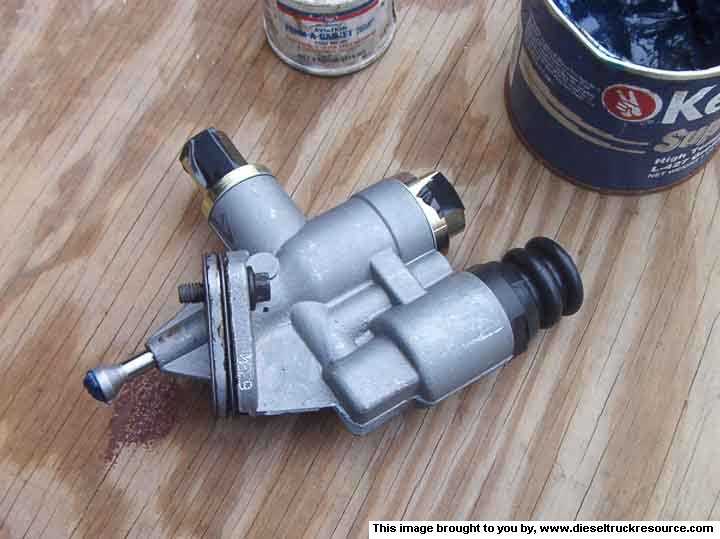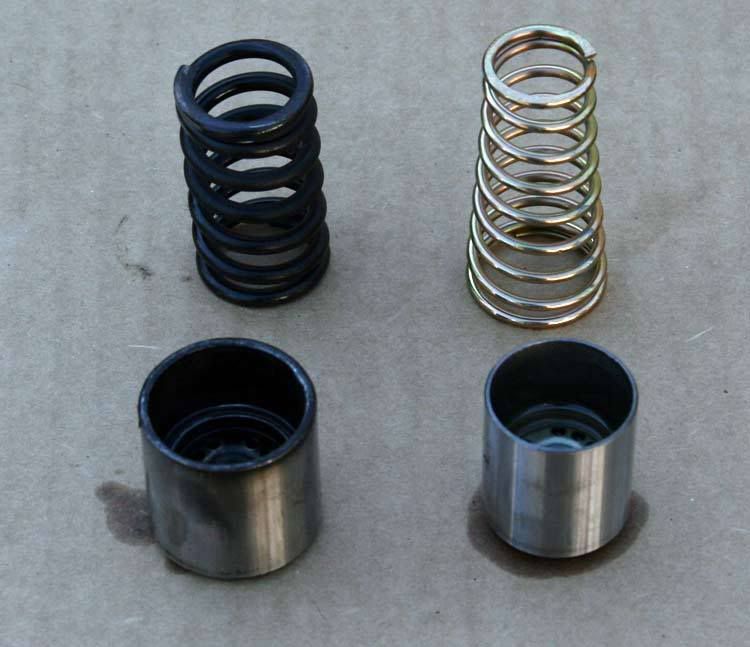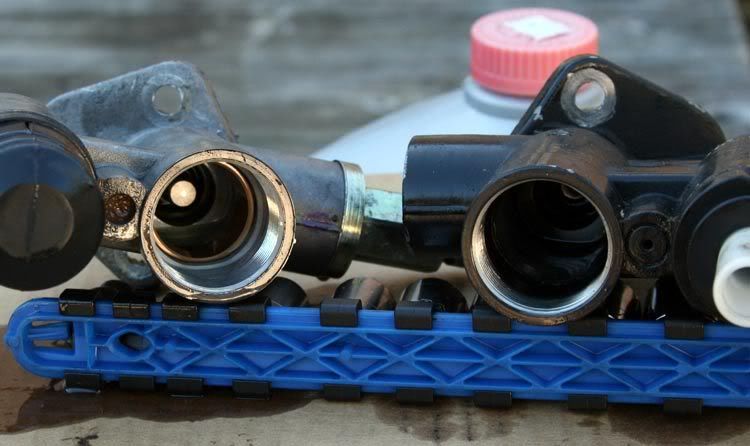Say What?! (Ref: Piston Lift-Pump)
#1
1st Generation Admin
Thread Starter
Like many here, I'm hooked on making more and more power with the ol' CTD.
February of last year, I upgraded my heap with the Cummins Piston Lift-Pump P/N~3936320 https://www.dieseltruckresource.com/...ad.php?t=93722

OK, fine .. ..
Since then I've upgraded the fuel line system to 6-AN (3/8" ID) plumbing from the in-tank fuel pickup all the way to the IP inlet. https://www.dieseltruckresource.com/...d.php?t=151190
I'm running one of the big fuel filters that Wannadiesel found. https://www.dieseltruckresource.com/...6&postcount=16
Um .. . . . I'm just now getting around to installing a fuel pressure gauge. I know, I know . . .
Fast forward . ..
So at this point, I'm working toward raising the IP fuel feed pressure to 15psig while under WOT conditions.
I've installed a bypass type fuel pressure regulator between the lift-pump and injection pump. I've connected a fuel pressure gauge in a temporary mounting till I can figure out where it's gonna go (Fred? .. . I believe that fella's got a FP gauge strapped to his windshield wiper. )
)
Anyhoot, . . .
With the lift-pump, running PDR "190" injectors with the typically tweaked injection pump, I'm seeing . ..
- Approximately 12psig while free-revving the engine to 2500rpm.
- Approximately 9psig at idle.
- Approximately 7psig under WOT.
OK, fine though I was thinking it would be higher.
So it's my understanding the VE injection pump performs at its best with an inlet fuel pressure of 15psig. It's also been my understanding the early 2nd gen 12v's run the same piston pump that's configured to produce about 30psig (free-revving to approx 2500rpm).
As part of this project, I recently bought a used '95 (I think it was) piston lift-pump thinking as has been suggested here, to simply swap the spring of the pump to raise its output pressure.
Not around my house!
Here's the deal . . .
While outwardly, the pumps are the same. There is however a big difference within. While the pump is configured to run with a higher output pressure, it also appears capable of supplying a much higher volume. A good thing.
The actual piston of the two pumps are different in that the true 2nd gen pump runs a piston of much larger diameter. (2nd gen piston and spring on the left, that we've been buying on the right) ~

The body of the pumps are exactly the same. The difference in the piston bore of the two is made up in that we run by way of a brass insert (see it in the left pump body) `

Seeing all that, I thought it'd be better to run the true 2nd gen pump in its entirety so as to take advantage of the higher volume potential.
Setting things up as such including the FP regulator has the fuel pressure now present as ~
- Approximately 15psig while free-revving the engine to 2500rpm (the FP regulator is limiting it).
- Approximately 13psig at idle.
- Approximately 14psig under WOT.
So my point of all this is perhaps one should reconsider the current "Piston Lift-Pump" install plan if one is after complementing a non-stock engine fueling deal. I realize there are plenty of big performance alternates available, but if you're not going all out, you might consider running the 2nd gen pump with a bypass style regulator to realize the goal.
Thoughts?
February of last year, I upgraded my heap with the Cummins Piston Lift-Pump P/N~3936320 https://www.dieseltruckresource.com/...ad.php?t=93722

OK, fine .. ..
Since then I've upgraded the fuel line system to 6-AN (3/8" ID) plumbing from the in-tank fuel pickup all the way to the IP inlet. https://www.dieseltruckresource.com/...d.php?t=151190
I'm running one of the big fuel filters that Wannadiesel found. https://www.dieseltruckresource.com/...6&postcount=16
Um .. . . . I'm just now getting around to installing a fuel pressure gauge. I know, I know . . .

Fast forward . ..
So at this point, I'm working toward raising the IP fuel feed pressure to 15psig while under WOT conditions.
I've installed a bypass type fuel pressure regulator between the lift-pump and injection pump. I've connected a fuel pressure gauge in a temporary mounting till I can figure out where it's gonna go (Fred? .. . I believe that fella's got a FP gauge strapped to his windshield wiper.
 )
)Anyhoot, . . .
With the lift-pump, running PDR "190" injectors with the typically tweaked injection pump, I'm seeing . ..
- Approximately 12psig while free-revving the engine to 2500rpm.
- Approximately 9psig at idle.
- Approximately 7psig under WOT.
OK, fine though I was thinking it would be higher.
So it's my understanding the VE injection pump performs at its best with an inlet fuel pressure of 15psig. It's also been my understanding the early 2nd gen 12v's run the same piston pump that's configured to produce about 30psig (free-revving to approx 2500rpm).
As part of this project, I recently bought a used '95 (I think it was) piston lift-pump thinking as has been suggested here, to simply swap the spring of the pump to raise its output pressure.
Not around my house!

Here's the deal . . .
While outwardly, the pumps are the same. There is however a big difference within. While the pump is configured to run with a higher output pressure, it also appears capable of supplying a much higher volume. A good thing.

The actual piston of the two pumps are different in that the true 2nd gen pump runs a piston of much larger diameter. (2nd gen piston and spring on the left, that we've been buying on the right) ~

The body of the pumps are exactly the same. The difference in the piston bore of the two is made up in that we run by way of a brass insert (see it in the left pump body) `

Seeing all that, I thought it'd be better to run the true 2nd gen pump in its entirety so as to take advantage of the higher volume potential.
Setting things up as such including the FP regulator has the fuel pressure now present as ~
- Approximately 15psig while free-revving the engine to 2500rpm (the FP regulator is limiting it).
- Approximately 13psig at idle.
- Approximately 14psig under WOT.
So my point of all this is perhaps one should reconsider the current "Piston Lift-Pump" install plan if one is after complementing a non-stock engine fueling deal. I realize there are plenty of big performance alternates available, but if you're not going all out, you might consider running the 2nd gen pump with a bypass style regulator to realize the goal.

Thoughts?
#2
Registered User
David,
Nice write up again. What kind of regulator are you running ? Are you running the steel fuel line off the lift pump or have you replaced it ? Any pics of the settup ?
Nice write up again. What kind of regulator are you running ? Are you running the steel fuel line off the lift pump or have you replaced it ? Any pics of the settup ?
#3
Registered User
Join Date: Feb 2007
Location: Pen Argyl Pennsylvania
Posts: 1,540
Likes: 0
Received 0 Likes
on
0 Posts
Sounds good to me. This is a upgrade I planned on doing in the spring. I think I will go with the 2nd gen pump, my question to you is what fp reg are you running (limit pressure) and where did you get it.
Thanks Ryan
Thanks Ryan
#4
1st Generation Admin
Thread Starter
I'm embarrassed to say it's expensive perhaps but I wanted one that is rated for diesel fuel, and large enough that pulsations from the piston pump wouldn't worry it to death. As such, I've got it mounted on the drivers fenderwell connected with my current 6-AN plumbing. For the return line, I've connected directly to the existing OEM fuel supply line (With my upgrade to 3/8" plumbing, the OEM line was left in place blanked off at the engine end).

Dana,
When I originally installed the piston pump, I couldn't find a fitting that would allow me to go directly to -AN hose fittings. I ended up taking a short piece of 3/8" soft copper tubing and slipping it over the OEM pump outlet tube, I braised it in place. As such it acts as a bushing so as to accommodate a common 3/8" tube to 6-AN adapter. (I cut the OEM pump outlet tube just after it turns away from the block).
Also note that in making the lift-pump swap today, I ended up simply swapping the pumps outlet adapter thing as the 2'nd gen version was about an inch shorter. In the end, I only swapped the actual pump body and the internal components.

Folks, I don't mean for this thread to be a "How-To". I'm just pointing out what I've found and looking comment.
I suppose if others have seen similar results with the lift-pump we've been buying, then perhaps I could re-write the "Piston Lift-Pump" install so as to incorporate todays finding.

#6
Registered User
With the flexible lines and A-N fittings, along with a gauge, it would be a simple matter to experiment with some of the other variations of the piston-pump, several of which can be had from various E-BAY vendors for extremely tempting prices.
Many that I see are genuine Cummins/Carter pumps, just weird part-numbers for un-known applications.
Who knows, by experimentation, a part-number may be found that pushes the volume needed, at the required pressure level, without the necessity of a seperate regulator.
I have searched in vain for an application-guide/pressure-volume comparison chart for the many piston-lift-pump part numbers, and there are a lot of different numbers made.
Many that I see are genuine Cummins/Carter pumps, just weird part-numbers for un-known applications.
Who knows, by experimentation, a part-number may be found that pushes the volume needed, at the required pressure level, without the necessity of a seperate regulator.
I have searched in vain for an application-guide/pressure-volume comparison chart for the many piston-lift-pump part numbers, and there are a lot of different numbers made.

#7
Adminstrator-ess
The reason for the bypass regulator is to let the pump use full pressure (45 - 50 psi in this case, up to 100+ on my Walbro setup) to push the fuel through the filter. This way you get full fuel pressure regardless of load. My setup runs 25 psi before the filter to make 18 psi after, I'm sure BC would see similar figures if he mounted a gauge pre-filter.
Trending Topics
#8
1st Generation Admin
Thread Starter
With my fuel supply system as presented above, the IP maxed out (fuel screw won't go in any further, home-cut fuel pin, etc) . . .
DDP4's can only pull the fuel pressure down to eight (8) psig [WOT at the end of an eighth mile track (8.81 @ 75.81 )].
)].
DDP4's can only pull the fuel pressure down to eight (8) psig [WOT at the end of an eighth mile track (8.81 @ 75.81
 )].
)].
#10
1st Generation Admin
Thread Starter
Yeah, I was wondering how much of an impact that figure would have on top performance. 
If anything, it certainly helps demonstrate the ability of such a relatively inexpensive fuel-pump set-up I think. (with a less expensive regulator
(with a less expensive regulator  )
)
Supports a set 190 caliber injectors fed by a maxed-out IP rather well it appears.

If anything, it certainly helps demonstrate the ability of such a relatively inexpensive fuel-pump set-up I think.
 (with a less expensive regulator
(with a less expensive regulator  )
)Supports a set 190 caliber injectors fed by a maxed-out IP rather well it appears.

#11
Adminstrator-ess
I'm not sure. I'm gathering pieces to put a case pressure gauge on my truck to see how much fuel pressure plays a role in keeping case pressure up.
My 1st gen piston pump working through the stock lines will keep 5 psi at full load, that's why I'm disappointed by your 8 psi figure.
My 1st gen piston pump working through the stock lines will keep 5 psi at full load, that's why I'm disappointed by your 8 psi figure.

#12
1st Generation Admin
Thread Starter
Perhaps this is a curve-ball for the consideration ~
I only run five to seven gallons of fuel in the truck when racing. I wonder how the launch and run down the track effects actual fuel pick-up in the tank, thus effecting the fuel pressure.
Of course, the fuel is being thrown to the back of the tank. Most likely, the fuel contained in the fuel sump of the pick-up assembly stands up on the back wall of the container and spills out at it's top on it's way to the rear of the tank.
Hmmmm . . . . ?
So I'm left with that in the 3/8" line going to the lift-pump.
?
.
I only run five to seven gallons of fuel in the truck when racing. I wonder how the launch and run down the track effects actual fuel pick-up in the tank, thus effecting the fuel pressure.
Of course, the fuel is being thrown to the back of the tank. Most likely, the fuel contained in the fuel sump of the pick-up assembly stands up on the back wall of the container and spills out at it's top on it's way to the rear of the tank.
Hmmmm . . . . ?

So I'm left with that in the 3/8" line going to the lift-pump.
?
.
#13
Adminstrator-ess
Off topic 1st gen dragstrip times discussion moved here:
https://www.dieseltruckresource.com/...d.php?t=177682
Off topic cold weather discussion moved here: https://www.dieseltruckresource.com/...d.php?t=177680
https://www.dieseltruckresource.com/...d.php?t=177682
Off topic cold weather discussion moved here: https://www.dieseltruckresource.com/...d.php?t=177680



